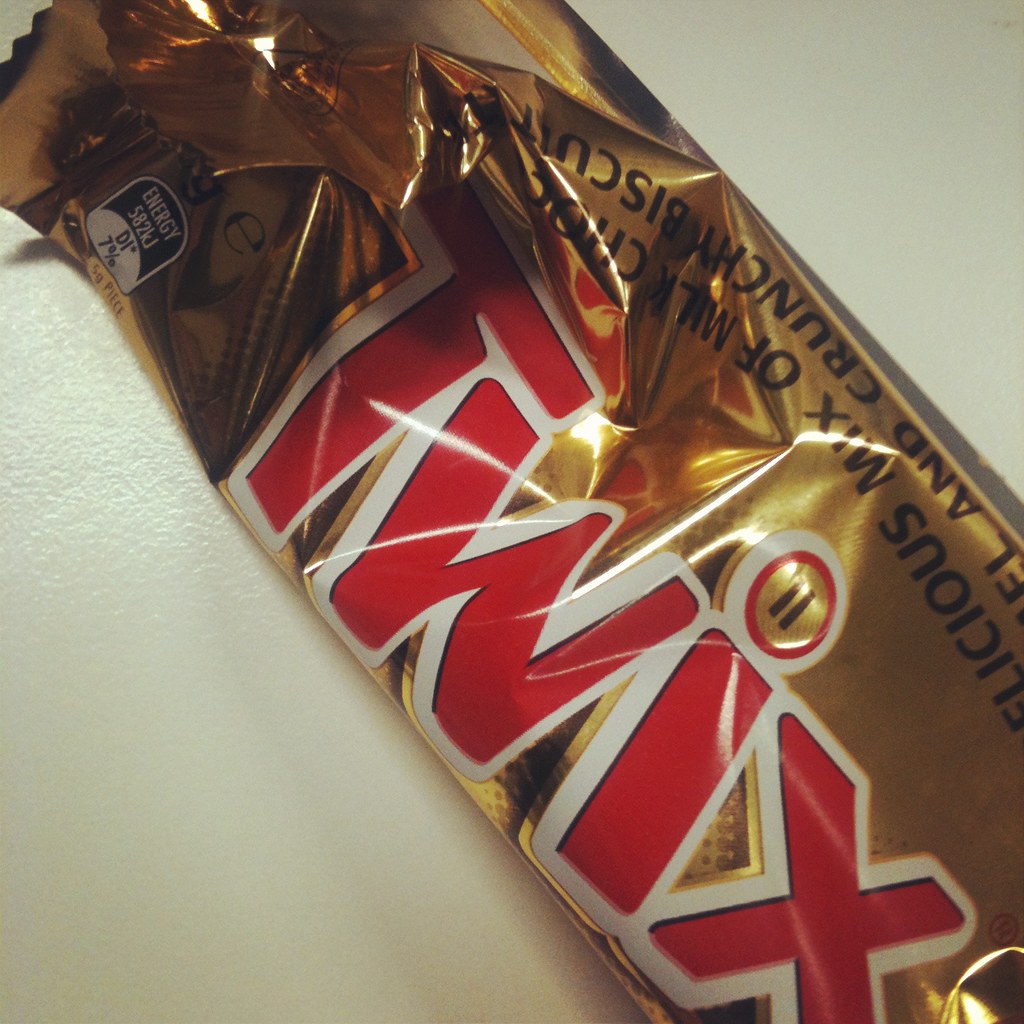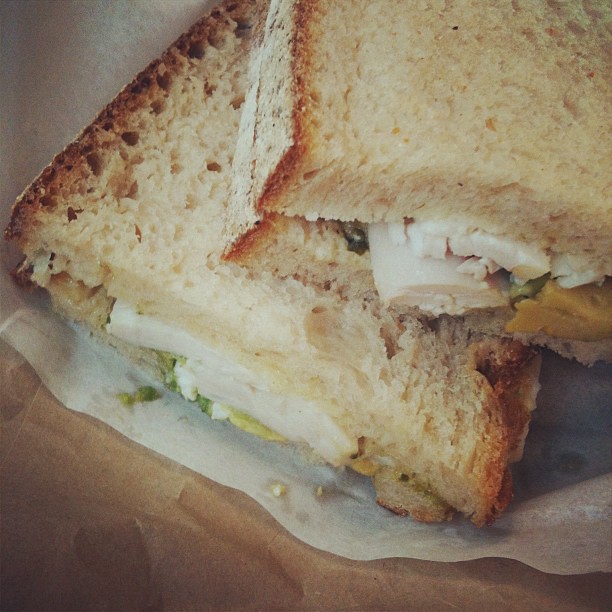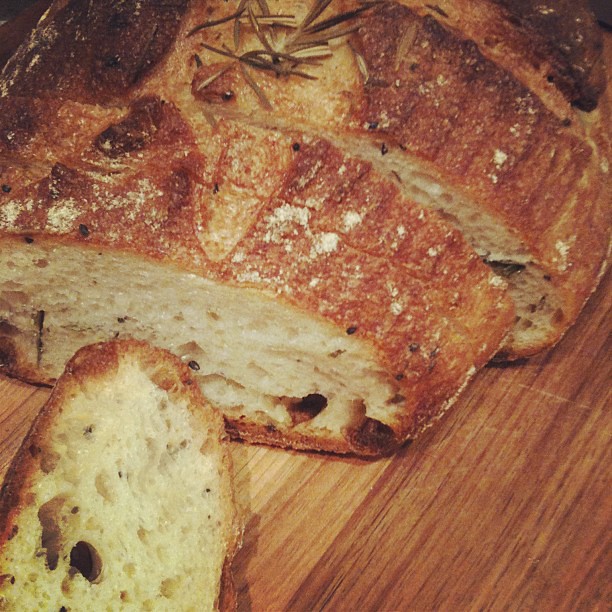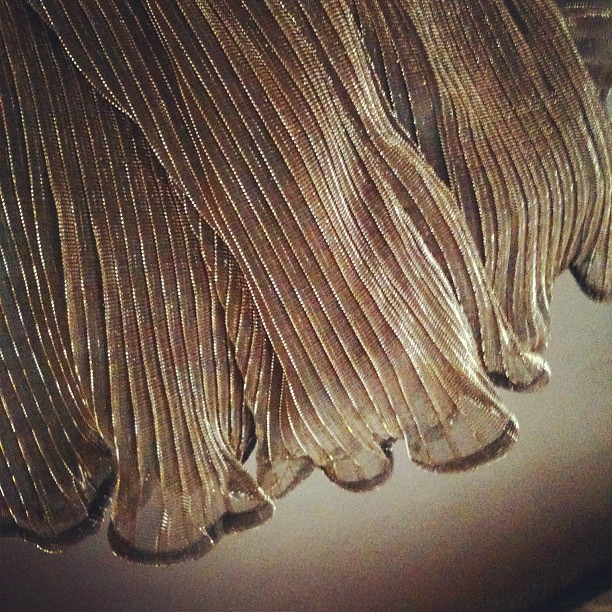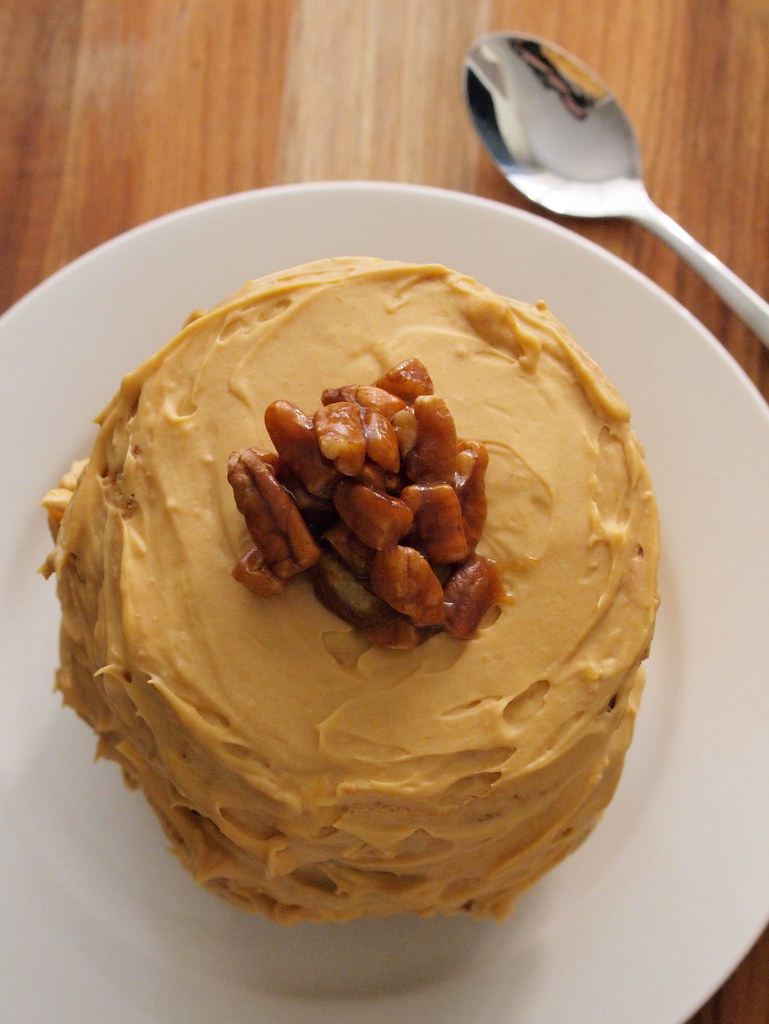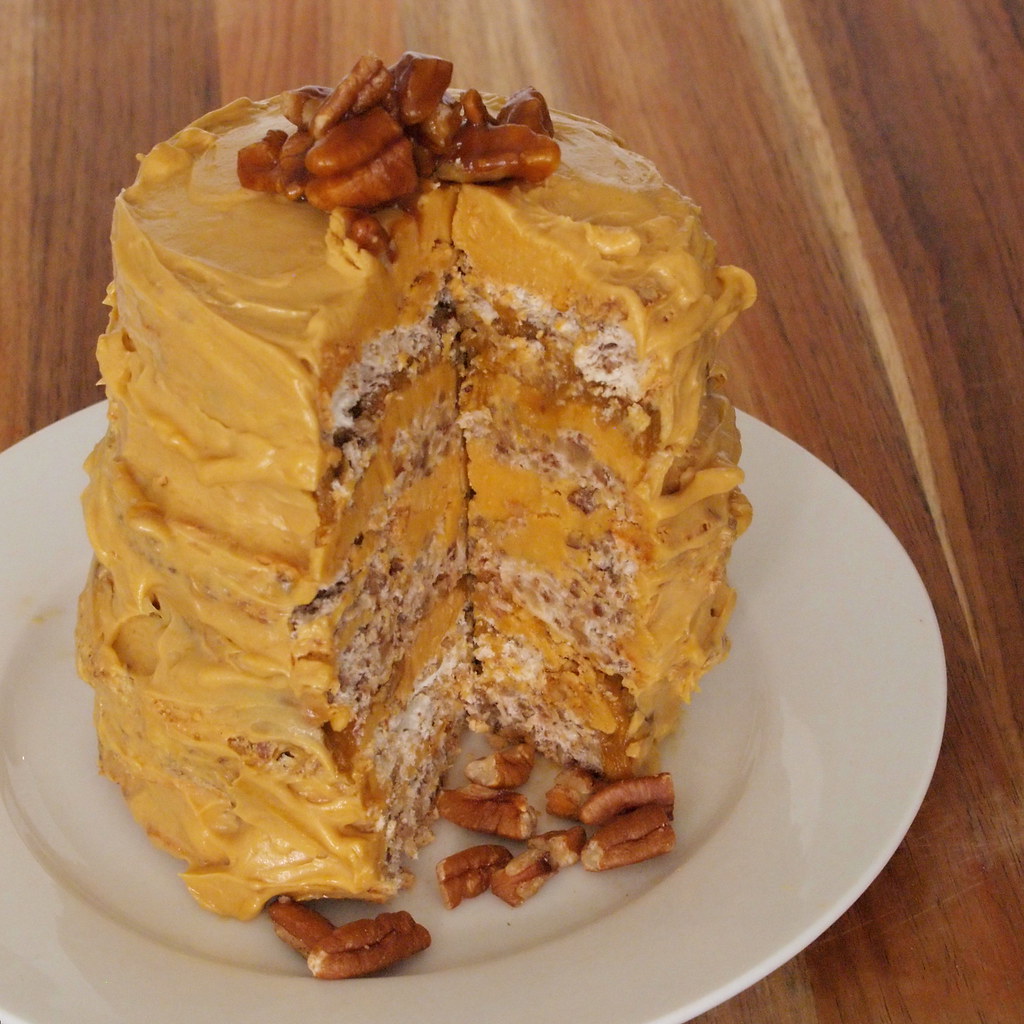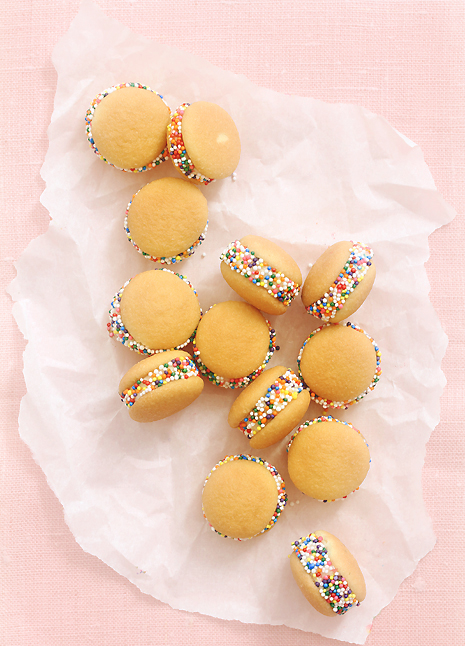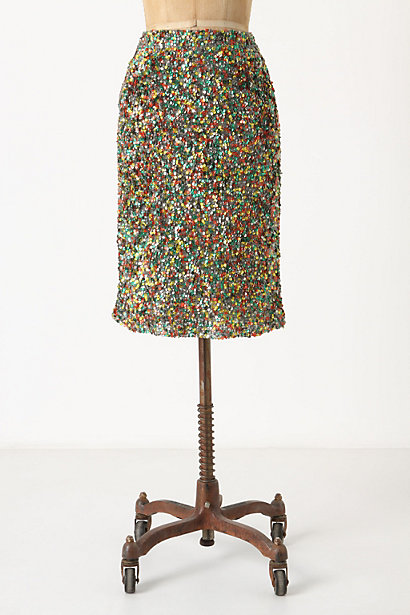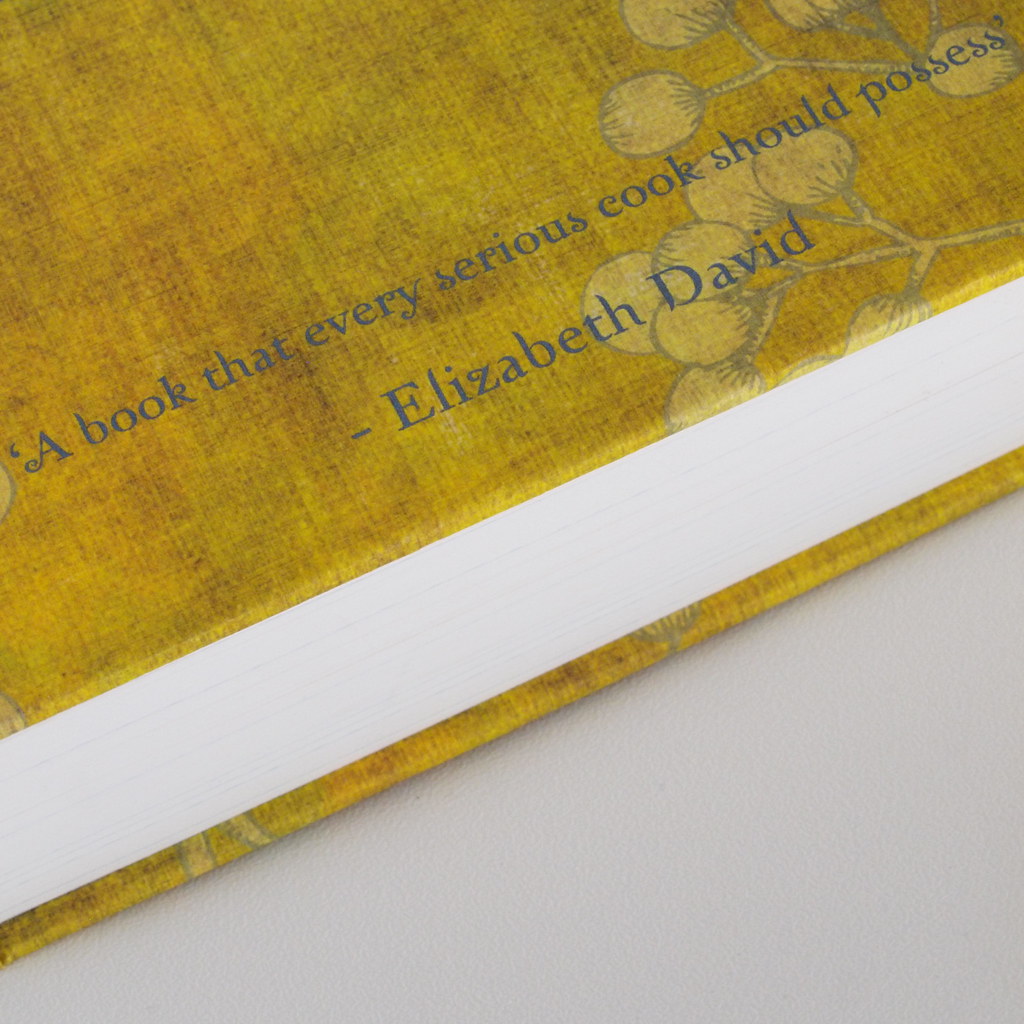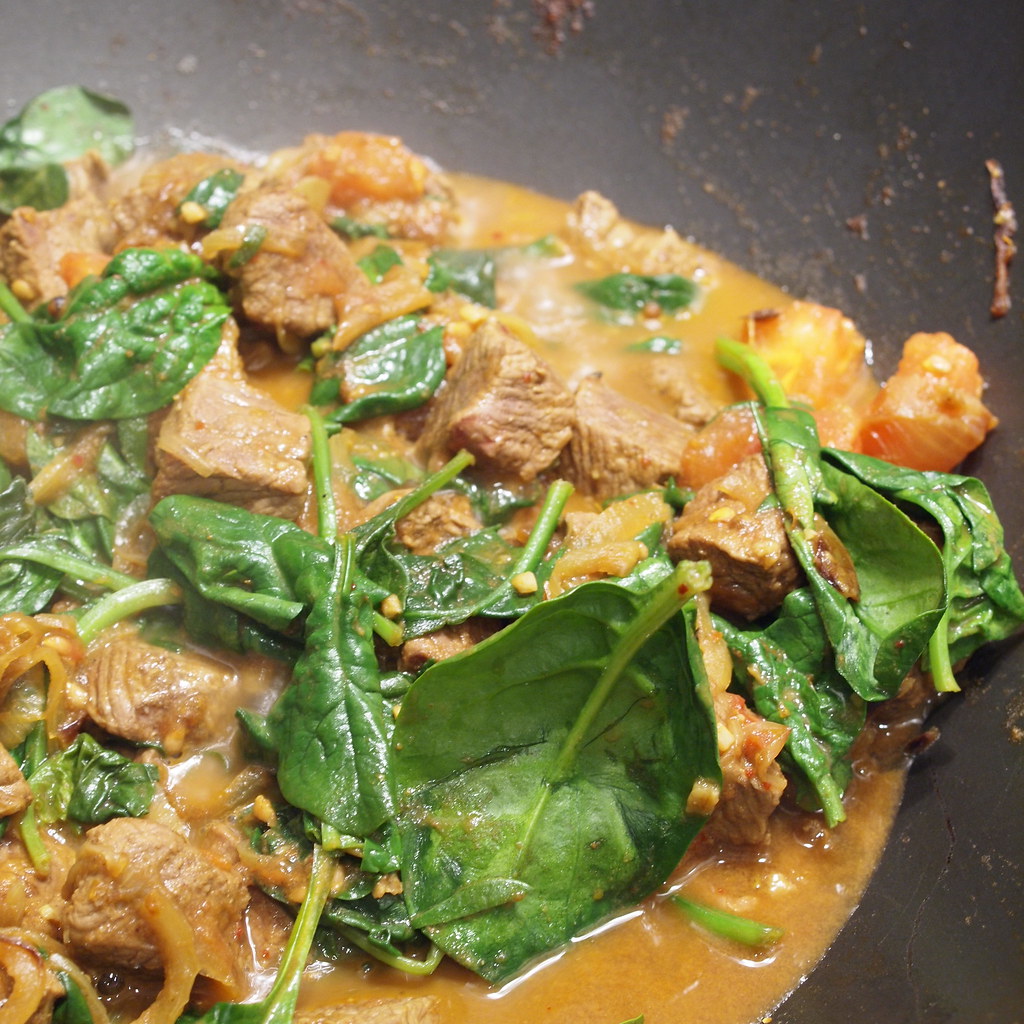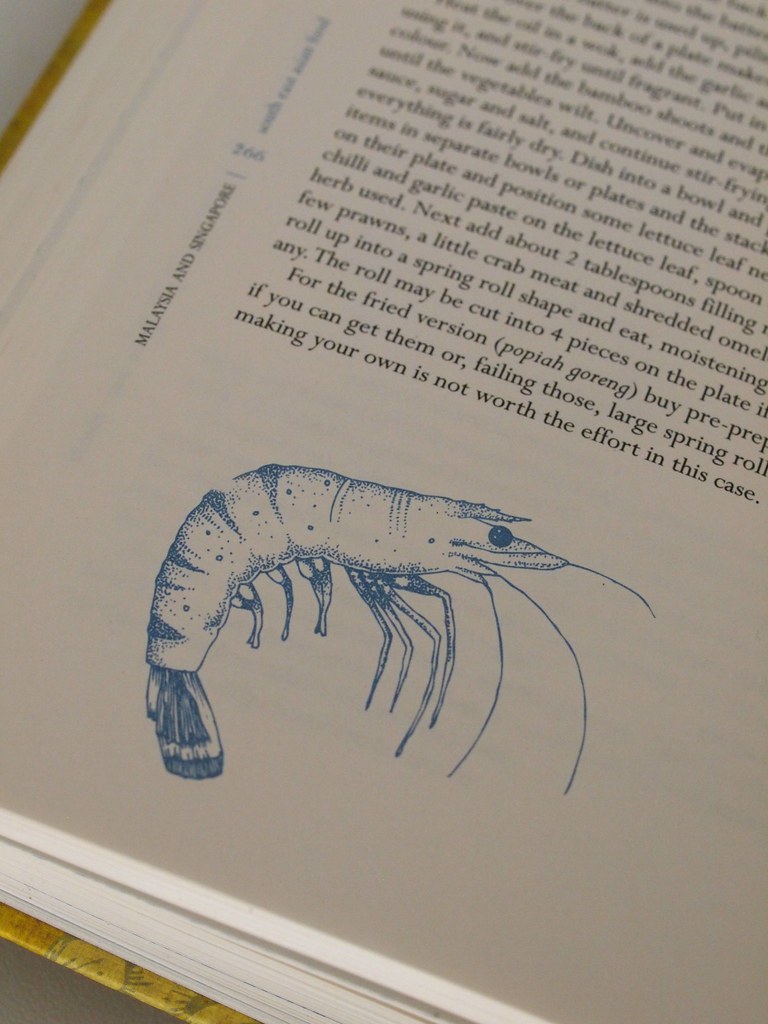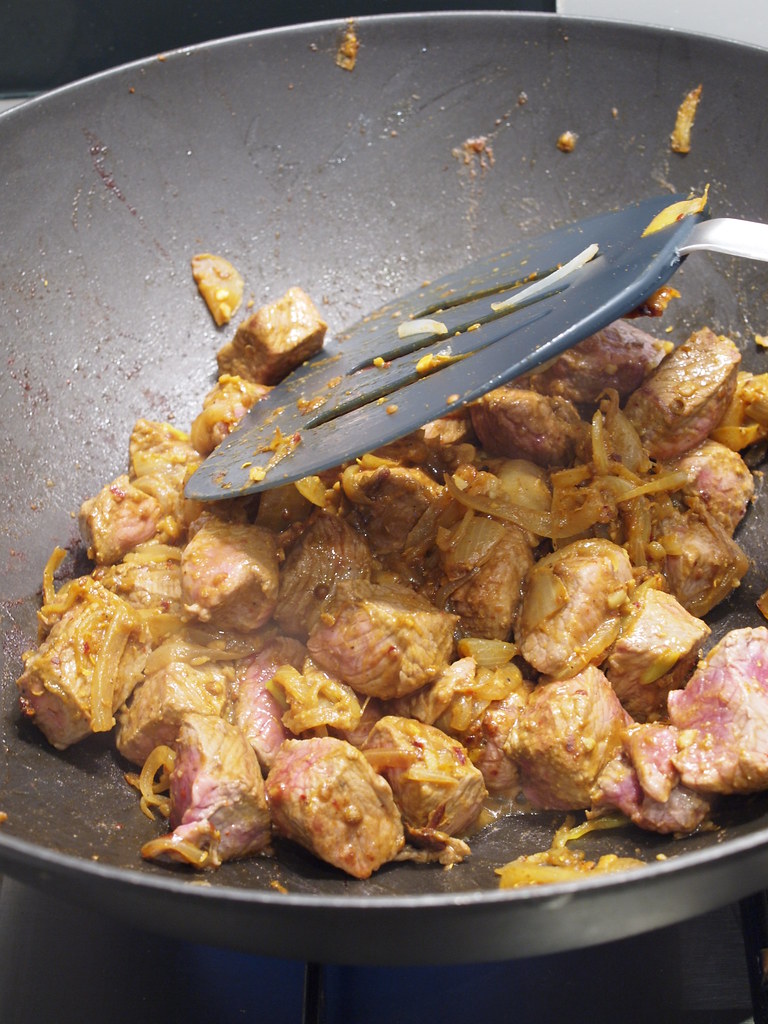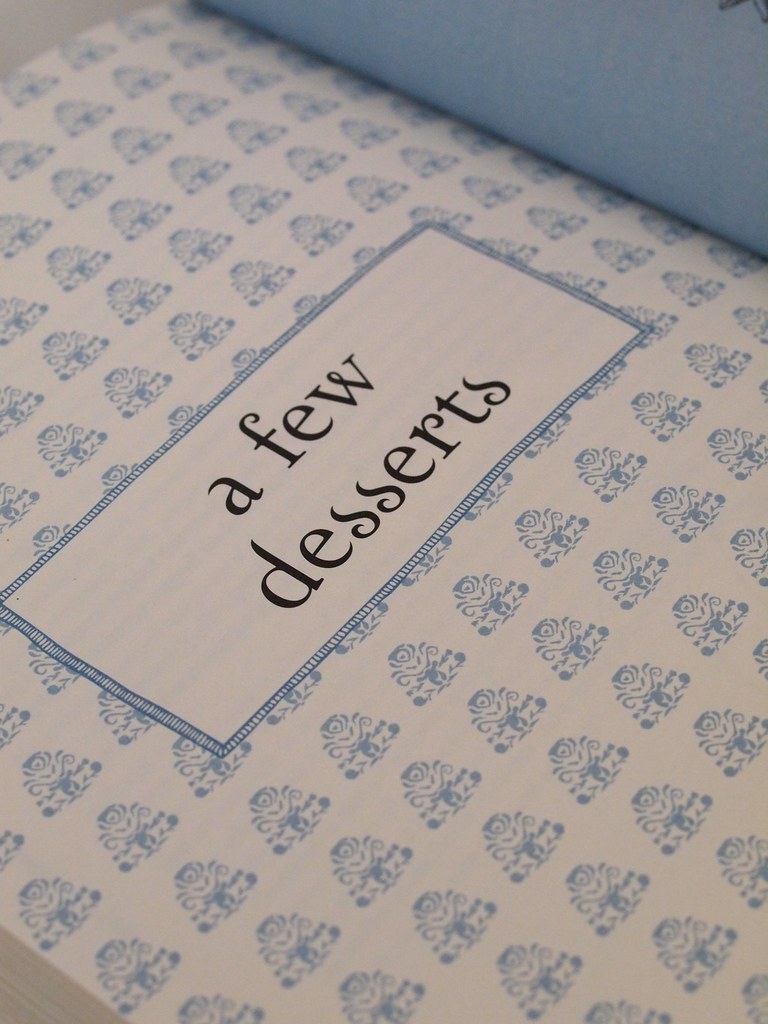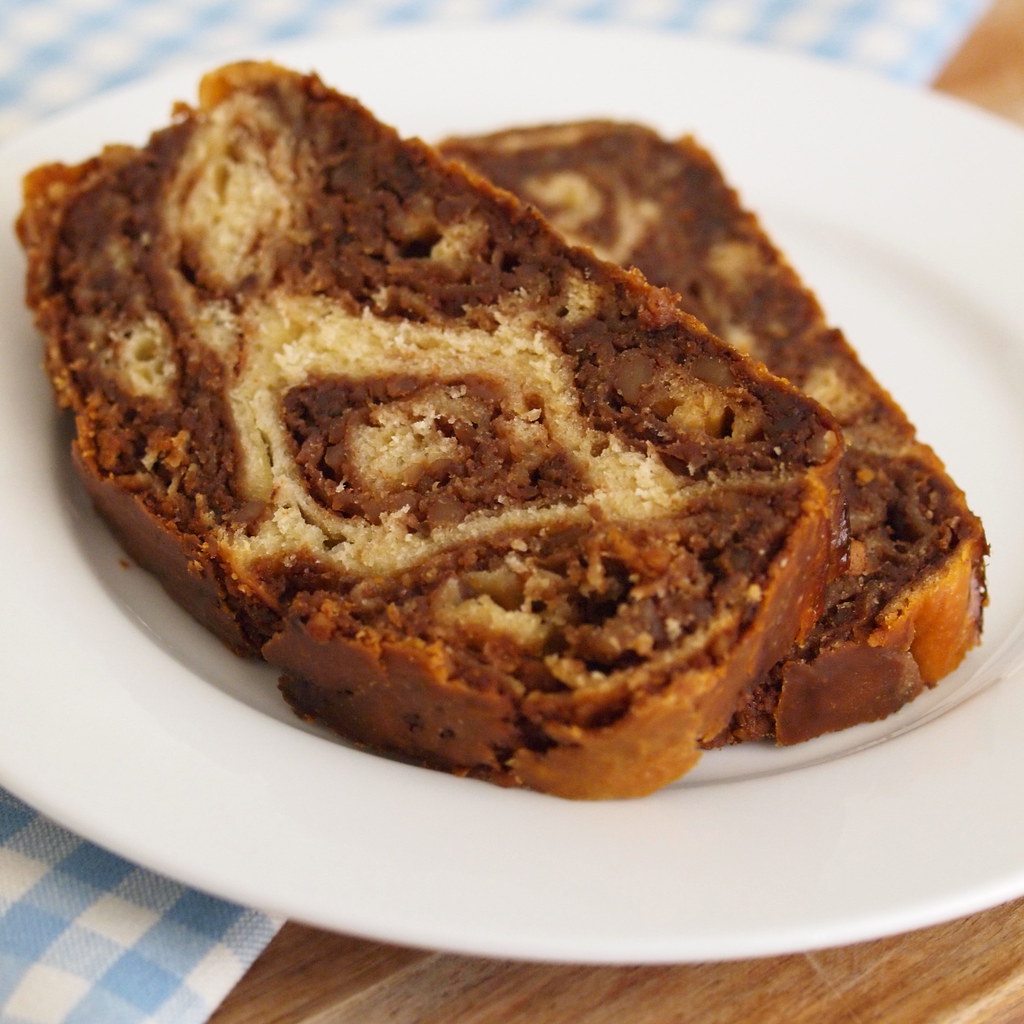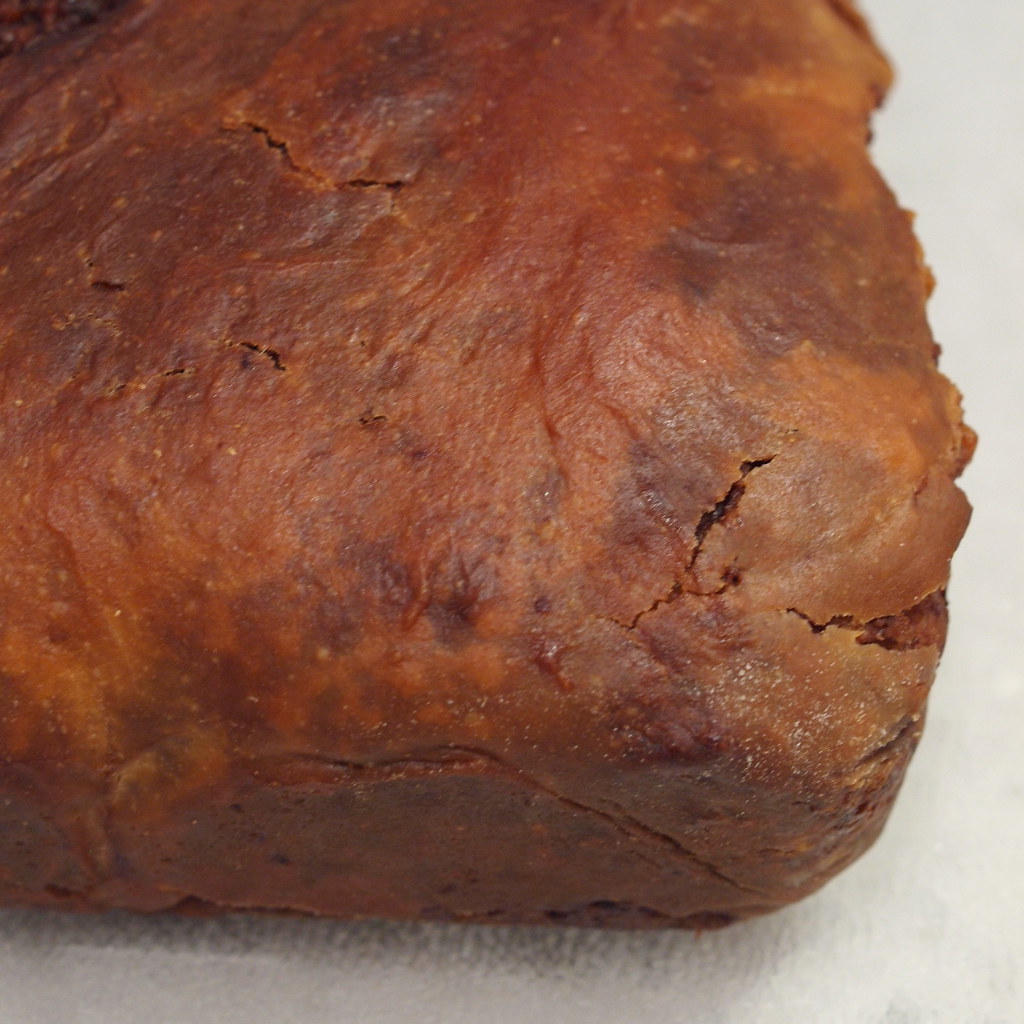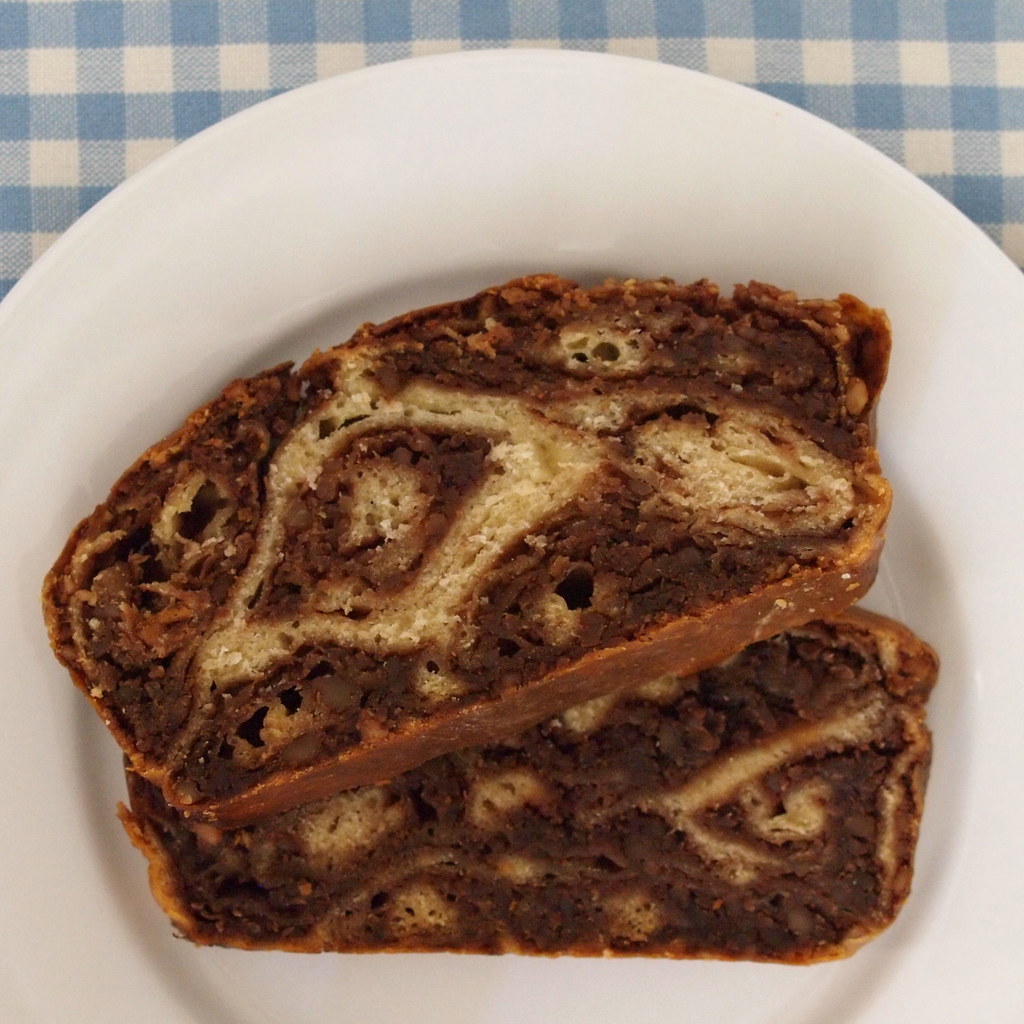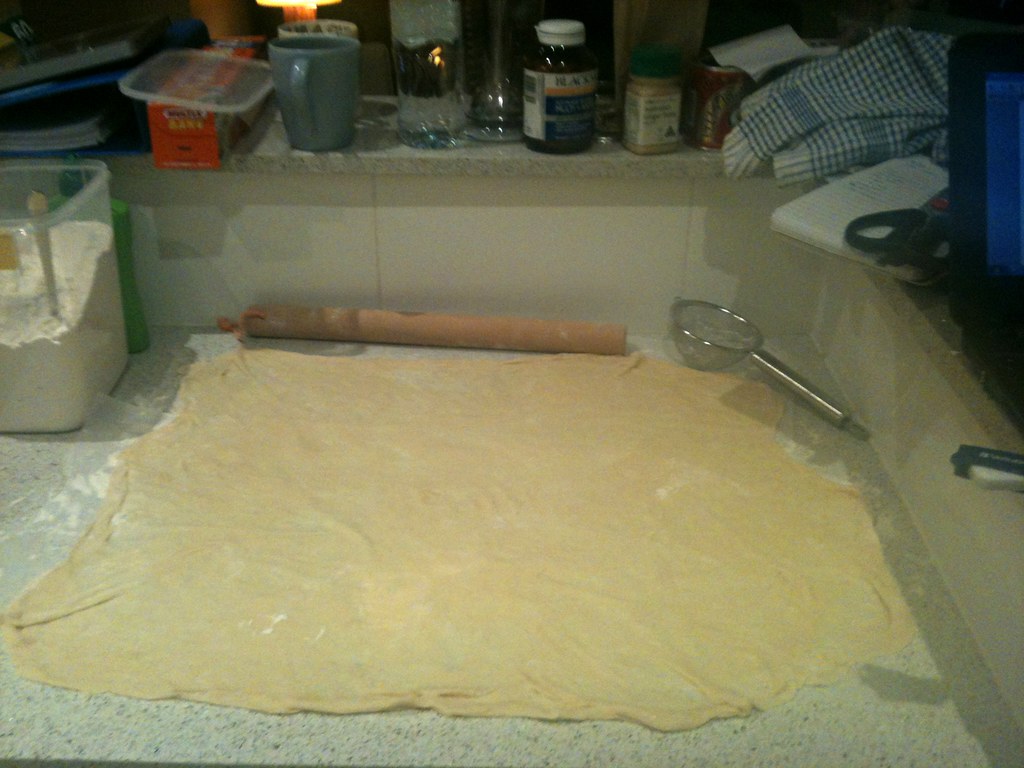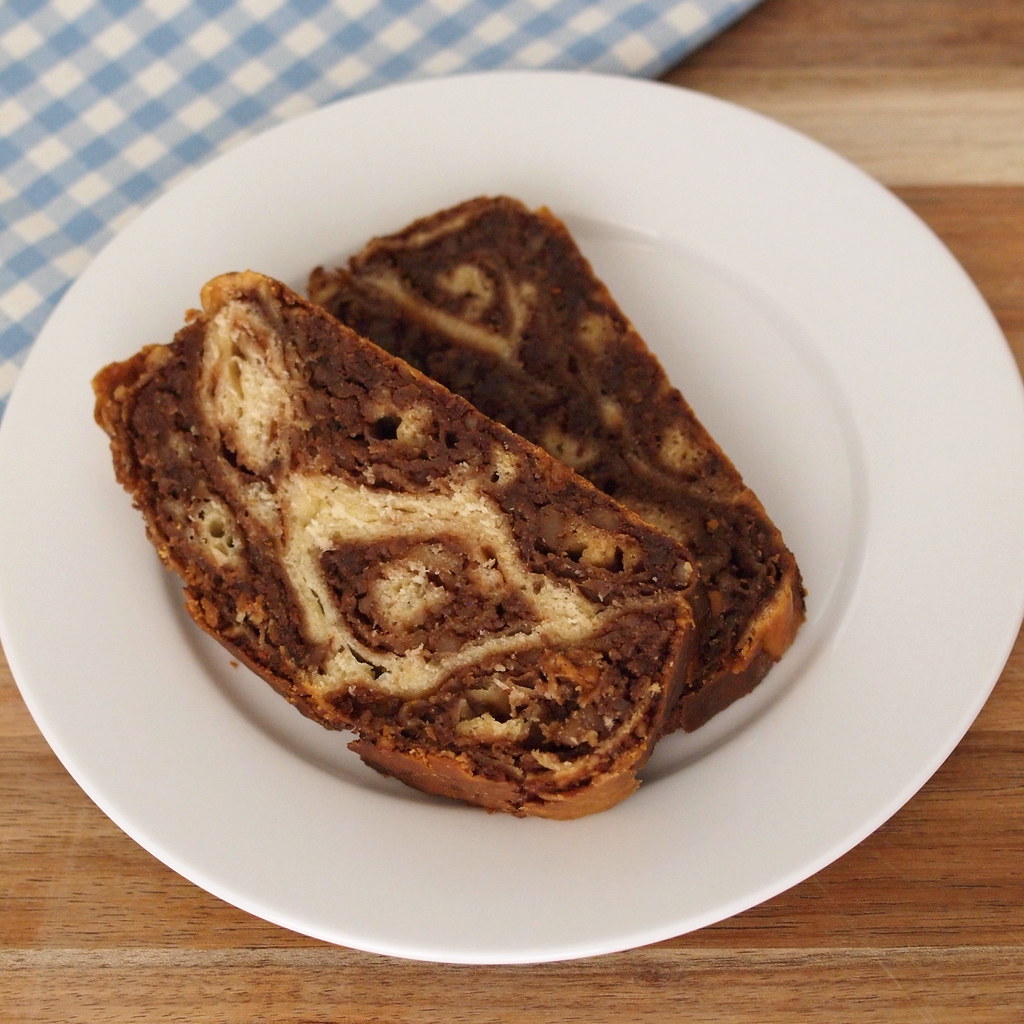Change can be good. Especially when you unexpectedly find it down the back of the couch. But if a change is as good as a holiday, too much change can feel about as comfortable as a three month trek across the Arctic wilderness in Jimmy Choos a size too small. Is the ice going to crack underneath me? Is that polar bear eyeing me off for its next meal? Have I got my heel caught in a crevasse?
So, having moved to a new role at work, and in a new grade in dancing, with an exam lurking menacingly round the corner (a bit like a hungry polar bear), I approached the prospect of Daring Bakers with trepidation. Can’t I just come up with another flavour of brownie and not go looking for unfamiliar and difficult things and poking them with a stick to see what happens? Nope…
Traditional walnut povitica
Some Daring Bakers challenges involving making something beautiful (as well as delicious). Lots of them involve making something that’s time-consuming (some of them, mind-bogglingly so). Almost all of them involve making something unfamiliar (because that’s the point). Not many of them involve something a little rustic round the edges, baked in a loaf tin. So, odds are that the rustic loaf is going to involve all sorts of trickiness and will take half the night. And it did. But it was so tasty I quite forgave it, through my sleep-deprived haze. And I was so pleased I gave it a try (even if it turned out a bit more resoundingly rustic than just around the edges).
The Daring Baker’s October 2011 challenge was Povitica, hosted by Jenni of
The Gingered Whisk. Povitica is a traditional Eastern European Dessert Bread that is as lovely to look at as it is to eat! It’s a sweet loaf made by rolling up thin dough spread with a filling so that each slice has a beautiful swirled pattern and every bite contains a mix of flavours. The traditional recipe combines ground walnuts with cinnamon, sugar and cocoa, but the recipe lends itself very well to experimenting with other sweet or savoury fillings. The recipe makes a monster four loaves, so there was lots of opportunity to try out some new varieties. As well as the traditional recipe, I also made:
- Caramelised white chocolate with chocolate chips (if you decide to do this version, you’ll need to have made the caramelised white chocolate in advance – or to be a vampire and so not need any sleep. Luckily, I had a jar I’d prepared earlier for the purpose... though since discovering this recipe, I’ll be needing to make some more)
- Peanut butter and strawberry jam
- Moreno cherry and ricotta
The povitica has a detailed swirl pattern in each slice
The most challenging part of the recipe involves rolling and stretching the dough to the requisite thin-ness and shaping it into loaves; otherwise, the recipe is relatively straightforward. It does involve quite a lot of “process” though – getting started late on a Sunday afternoon with the added distractions of a (thankfully rare) crash of the Daring Bakers site and an (even more thankfully rare) lengthy phone call by the Other Penguin to wrangle a travel arrangements, during which the noisy machinations of the KitchenAid would not have been well received.
The finished loaves, however, were definitely well received. They came out a deep golden brown and their unexpected heft belied their light-but-filling texture. When cut open, the filling formed a clear swirl pattern – I’d been a little worried it might just become a jumbled, albeit tasty, mixture. The different fillings impacted the consistency of the loaves, as well as their cooking time – the walnut and peanut butter versions came out dense and tightly coiled, while the cherry and ricotta one took quite a bit longer to cook through as the filling was wetter. As helpfully foreshadowed in the comments for the challenge, allowing the bread to cool completely and to sit overnight in the fridge made it easier to cut evenly. Even so, it was a little crumbly round the edges, probably from how it was rolled up and coiled into the tin.
The crunchy golden crust on the peanut butter and strawberry jam povitica
I tried a little of the peanut butter and the walnut versions, and was pleasantly surprised. The bread itself was sweet-tasting, and reminded me of a heavier version of Chinese milk bread. Combined with the well-dispersed filling, it had an unexpectedly subtle flavour and was neither too plain nor too stodgy. The traditional walnut version was It’s well suited to a simple morning or afternoon tea, but could also be good at breakfast time (I’d be interested to see how it came out if you toasted it) or for one of those late-afternoon high teas which graze across baking, charcuterie, cheese and fruit (one of my favourite things about Christmas with my family). The bread is quite filling, so more than one of those options might leave you a little sleepily full, much as I’d love to advocate baked goods for every meal!
I would definitely like to try making the dough again, although next time I’ll scale it back to half the quantity and just make two loaves. A marzipan version, a little like a swirly stollen, is an appealing possibility. More likely, though, is that I’ll try using the dough for loaves or small rolls without the swirled filling, or with some fruit or chocolate scattered through. A dark chocolate chip version might even tame my longing for a pain viennois chocolat, which I’ve been carrying since that wonderful discovery in Paris last year.
If you’d like to try making povitica ("povateetsa") for yourself, here’s how it was made:
What you need
To activate the yeast
2 tsp / 9 g sugar
1 tsp 3 g plain flour
2 tbsp / 14 g dry yeast
½ cup / 120 ml warm water
Dough
2 cups / 480ml full cream milk (as we don’t tend to have this around, I referred to
Joy of Baking and substituted skim milk with 50 g extra butter added)
¾ cup / 170 g sugar
3 tsp / 18 g salt
4 large eggs (at room temperature, lightly beaten)
½ cup / 115 g butter (melted and cooled)
8 cups / 1.12 kg plain flour
Walnut filling (these quantities were for one loaf – if you make the above dough recipe and want to do all of them with this filling, it’ll need to be scaled up by 4)
1 ¾ cups / 280 g walnuts (ground – I used whole ones and whizzed them in a food processor)
½ cup / 113 g sugar
2 tbsp cocoa powder (this is way more than the recipe called for in the original recipe, but I wanted to go extra chocolatey, and also to have a greater colour contrast in the swirls)
¼ tsp cinnamon
¼ cup / 60 ml milk (I used skim)
¼ cup / 56 g butter
1 egg, lightly beaten (note: the recipe for the full quantity, which makes 4 times this amount, uses 2 eggs – as others had needed to add more milk to make the filling wetter, it seemed sensible to use a whole egg and no extra milk, than to use half an egg and get rid of the other half – this worked well – the mixture didn’t need any extra milk to be spreadable)
¼ tsp vanilla extract
Peanut butter and jam filling
240 g peanut butter (I used smooth, but crunchy would work well for the textural contrast)
55 ml milk (just under ¼ cup)
400 g jam (I used strawberry)
Ricotta and cherry filling
375 g light smooth ricotta
200 g (approximately) Moreno cherries (squashed), plus 3 tbsp (45 ml) juice from the jar (a small splosh, for those of a less precise persuasion)
Caramelised white chocolate filling
1 batch of caramelised white chocolate (made from 400 g white chocolate, using
this recipe)
White chocolate chips – enough to cover the dough as liberally as you wish (I used around 150 g))
Glaze (for traditional version)
¼ cup / 120 ml strong coffee (cooled)
2 tbsp / 28 g sugar (which I added to the hot coffee so that it dissolved)
Melted butter
Glaze (for the other versions)
1 egg, lightly beaten
2 tbsp / 28 g sugar (which I added to the hot coffee so that it dissolved)
Melted butter
The dough needs to be rolled our very thinly before being spread with the filling
What to do
To activate the yeast
1.
Put 2 teaspoons of sugar, 1 teaspoon of flour and 2 tablespoons of yeast
into a jug or small bowl. Stir and then add 120 ml warm water and stir again to
combine.
2.
Cover with plastic wrap, put in a warm place in the kitchen and allow to
stand for 5 minutes.
Note: if you activate the yeast before
starting making the dough, as I did, it ends up sitting for a lot longer than 5 minutes, although this
didn’t seem to cause a problem. Next time, though, I would activate the yeast
part-way through making the dough, after removing the scalded milk from the
heat (step 3 below).
To make the dough
3.
Heat the milk (or, if using skim milk, the milk and 50 g extra
butter) in a saucepan until just below boiling point (about 180°F/82°C),
stirring regularly so that a skin doesn’t form on top. It should be scalding
hot, but not boiling (this can be done using a sugar thermometer, or just by
eye and experience). Allow the milk to cool slightly (until it is about
110°F/43°C, or very warm but safely bearable to the touch – this took about 10
minutes, for the avoidance of burnt fingers, for anybody else who lacks
asbestos hands!).
4.
In the bowl of a stand mixer (or a large bowl if you’re going to mix
the dough by hand), combine the cooled scalded milk, 170 g sugar, and 3
teaspoons salt.
5.
Add the lightly beaten eggs, yeast mixture, cooled melted butter, and
280 g of the sieved flour (about a quarter of the total amount).
6.
Mix thoroughly and slowly add the remaining flour (840 g if you use
it all), mixing well until the dough starts to clean the bowl. Note: At this
point, much as I’d seen from the challenge that the dough was meant to be quite
sticky and that others didn’t need all 1.12 kg of flour, I decided it was
entirely too sticky and added around another 75 g (½ cup) of flour. It was
still very sticky, but at that point I decided to live with it and see what
happened, which ended up turning out quite well).
7.
Change the mixer attachment from the beater to the dough hook and
knead until smooth (if making the dough by hand, turn – or, perhaps more
likely, scrape – the dough out onto a floured surface and knead, gradually adding
flour a little at a time, until smooth and a bit less sticky). As I was making
the dough in the ever-reliable KitchenAid, I didn’t add any more flour at this
stage (although I did worry whether I should – this was even stickier than
brioche dough).
8.
Divide the dough into 4 equal pieces (they should each weigh about 550
g).
9.
Place the dough into 4 large lightly oiled bowls (large saucepans
work if you’re starting to run out of bowls – if you’re starting to run out of
kitchen bench space by now, you’re in the same spot I was in...) cover loosely
with a layer of plastic wrap and then a tea towel. Allow the dough to rest and rise
for 1 ½ hours in a warm place, after which it should be roughly doubled in
size.
Traditional walnut filling
10. Place
the ground walnuts, sugar, powder and cinnamon and cocoa powder in a bowl and
stir to combine.
11. Heat
the milk and butter to boiling and pour over the nut and sugar mixture.
12. Add
the egg and vanilla and mix thoroughly.
13. Allow to stand at room temperature until ready to be spread on the dough. (If the
mixture thickens, add a small amount of warm milk – I didn’t need to do this
having scaled the recipe to use more egg).
To roll and fill the dough and make the loaves
14.
Preheat oven to moderate 180°C / 350°F, and line your loaf tins with baking
paper (I only had two loaf tins, so I baked in two batches).
15. Cover
the kitchen bench with non-stick baking paper, ensuring it overlaps so there
aren’t any gaps.
Note: The original recipe advocates
rolling the dough, and forming the loaves, on a clean sheet or cloth – I’ve
found previously, with dough – including phyllo – that baking paper seems to
work just as effectively for this purpose, and creates less washing (which is
important, given this recipe seems to use almost every utensil in the kitchen,
as well as most of the tea towels).
16.
Sprinkle the paper with a couple of tablespoons to a handful of sieved flour
(use flour sparingly, but ensure there is a light sprinkle over the whole
surface as, without it, the dough may well stick when you go to roll it up).
17.
Place one of the four blobs of dough on the baking paper and roll it out with a
lightly floured rolling pin, starting in the middle and working your way out,
until it is roughly 40 cm square (15 inches).
18.
Using a combination of the rolling pin and your hands, roll, stretch or gently
pull the dough out from the centre until it is thin and a consistently
almost-translucent. You should be able to see the outline of a pattern through
the dough (if you slide a picture or some writing under the baking paper). Try
to keep the shape roughly square. Gently sliding your lightly floured hand,
palm down, beneath the dough as you go will help make sure it doesn’t stick to
the paper.
19. Dollop
filling evenly over the rolled out dough and, using a spoon or your fingers,
spread over the dough until evenly covered.
20. Gently
and tightly roll up the dough. There are several ways to do this:
- The easiest way is to just roll the dough along its horizontal edge
(either from front to back or from back to front depending on which is easier –
I found this was much of a muchness) until you have one long, thin sausage of
dough. Then, coil the dough around itself into the base of the loaf tin (a
little like in the picture shown, courtesy of the Daring Bakers website):
- Alternatively, roll the edge of the dough nearest you into the centre,
and roll the edge furthest away into the centre, so there are two long sausages
of dough joined up beside each other. Then, carefully fold the long ends of the
sausage on top of each other (so that you have a roughly loaf-shaped lump which
is two sausages wide, and three sausages high), as shown in the diagram below from the povitica genius at Wolf's Den.
21. Repeat the filling and rolling process with the remaining three blobs of dough
to create another three loaves, coiling each sausage of dough in its own loaf
tin. The different fillings I used are prepared as follows:
Peanut
butter and jam
Place the peanut butter and milk in a
microwave-safe bowl or a small saucepan, and heat until the peanut butter is
soft. Stir thoroughly until well combined. Spread the peanut butter evenly over
the rolled out dough. Then, dollop with strawberry jam and spread this evenly
over the peanut butter layer. Roll up as explained above.
Ricotta
and Moreno cherry
Mix the ricotta, cherries, and extra
cherry juice in a small bowl until thoroughly combined. Spread evenly over the
rolled out dough. Roll up as explained above.
Caramelised
white chocolate
Warm the caramelised white chocolate in
a microwave or small saucepan until it reaches a slow pouring consistency.
Spread evenly over the rolled out dough, and sprinkle evenly (and liberally)
with white chocolate chips. Roll up as explained above.
22. Brush the top of the traditional loaf with the coffee glaze (a mixture of 60 ml
of strong coffee and 2 tablespoons of sugar, cooled). For other fillings, I
used a glaze of a beaten egg and 2 tablespoons of sugar).
23.
Cover tins lightly with a tea towel and allow to rest for around 15 minutes.
24. Place
the tins (without tea towels) into the preheated oven and bake for
approximately 15 minutes.
25. Turn
down the oven temperature to slow 150°C / 300°F/ and bake for an additional 45
minutes, or until the top of the loaves are golden and crisp, the texture is
firm rather than squishy when gently prodded and a thin skewer inserted into
the centre comes out clean. Check on the loaves after a total of about 30
minutes, to ensure they’re not getting too brown – if that looks to be
happening, cover them with a sheet of aluminium foil.
Note: I did the first two loaves with
the oven initially hotter, then turned down after 15 minutes, and found that
the walnut and cherry versions took quite a different time to cook through (the
cherry one took almost 15 minutes longer). Consequently, I decided to turn the
oven up to the higher temperature for the second batch, and left it there
throughout. These second loaves took around an hour to cook, and didn’t end up
too dry from the hotter temperature – and it’s less faffing about with a
still-rather-temperamental oven!).
26. Remove bread from oven and brush with melted butter. Allow the
loaves to cool on a wire rack for 20-30 minutes, preferably still in the bread
pan. (If it’s stupid o’clock and you’ve still got two loaves to cook and need
to use the loaf pans, turning them out earlier won’t kill them, but might mean
they sink a little as the baked loaves are quite heavy and cooling them in the
tin helps them to hold their shape. I think the varied shapes of mine had more
to do with slight differences in the rolling technique than with the cooling
process).
27. The loaves can be cut into slices with a serrated knife and it is
apparently (and which I overlooked, rather to my regret) easier to do so after
turning the bread upside down. I’d be interested to hear from other folks
who’ve tried this recipe whether that’s the case and why. I did find they
sliced more easily after being refrigerated overnight.
Warning: resting povitica dough may take over your kitchen!
But the results are worth it...
Read more...




